Six students from the Product Design Program recently took home $5,000 in prize money from a “Shark-Tank”-style competition—dubbed “Duck Tank”—open to students across campus to develop a new mobile app. A total of $15,000 was handed out to four interdisciplinary teams to help them take their ideas to the next level.
The two winning product design student teams were among sixteen teams who submitted proposals; four teams were selected to pitch their concepts to prospective investors and industry leaders during the Colligan User Interface Design Challenge in January at UO.
The event sought to inspire UO students from all programs and classes to create a graphical user interface (GUI) for consumer use on a mobile platform.
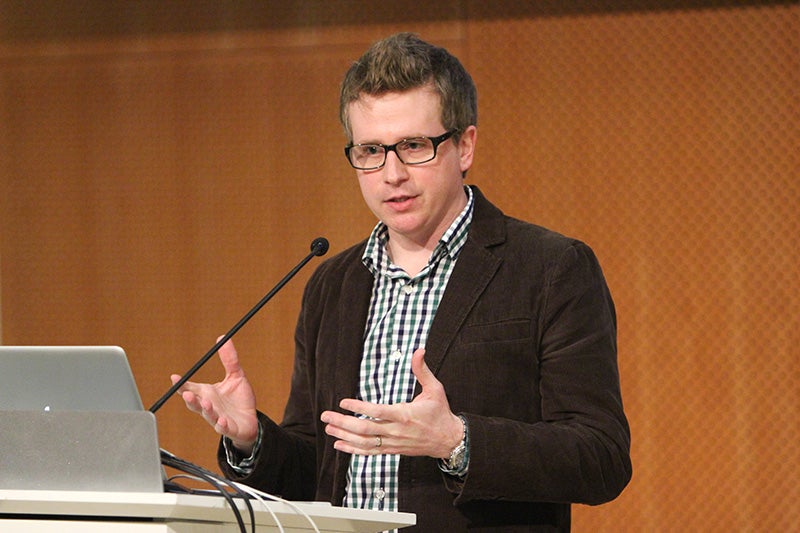
Above: Jason Germany, assistant professor in the Product Design Program.
Jason Germany, assistant professor in the Product Design Program, had taught a fall 2013 studio—Product Interaction Design: Wearable Computing & Quantified Self—that, while not intended to provide entries for the competition, offered skills directly applicable to the competition.
“We examined graphical user interface in mobile computing and wearable computing options,” Germany said of the studio.” His course syllabus further elaborated on the class objectives: “[The] growing domain of wearable computing has recently moved from research labs to consumer markets with releases of products like Nike Fuel Bank, Fitbit, and Jawbone Up. The goal of this course is for students to conceive of new ways in which self-monitoring can aid users beyond many of the current concepts.”
The Colligan User Interface Design Challenge took place over three months, with interdisciplinary teams collaborating across campus to create new mobile interface concepts. The competition was the result of a vision brought to the office of Research, Innovation, and Graduate Education by UO alumnus Ed Colligan, ’83, the former CEO of Palm, Inc. and Handspring. Colligan funded the competition for two years.
The concepts from the two winning product design team focused on medical concerns.
Team IRIS, comprised of students Sara Birns, Logan Olson, and Claire Sakaguchi, took home $4,000 and second-place honors. Their app is designed to help break the communication barrier between doctor and patient in international medical contexts. The students named the system IRIS after the goddess of communication.
“In many small, rural towns in Third World countries, a majority of the doctors and specialists are not trained locally. Many of them are educated in the U.K. or U.S., therefore English is their first language,” said team member Claire Sakaguchi. “So when they travel abroad to work, it is not their ability that gets in the way of proper diagnosis, it is the language barrier.”
IRIS can do three things: read body vitals, provide real time text and oral translation, and provide a map and data entry point for epidemiology-related content. “We aim to do a few things simply but with accuracy and speed,” Sakaguchi said.

Above: Ed Colligan (right), the former CEO of Palm, Inc. and Handspring, and Rob Haitani, a principal UX designer at Amazon.com, Inc., watch a student team’s presentation during the Colligan Challenge. Colligan funded the competition for two years. Photograph by Jack Liu.
Once the team had settled on a medical diagnostics focus, the challenge was “determining what we wanted our wearable device to look like. We knew the functionality but were unsure how we wanted it worn,” she said. “We ultimately went with a head-mounted device because it is reminiscent of devices doctors used to wear on their heads back in the day.”
Team T-Back, comprised of Cole Harder, Yawei Zhang, and Yu Zhang, took home $1,000 for their fourth-place finish. The three developed a system to monitor and track the physical status of delivery workers to help prevent injuries.
The T-Back App is fitted on a lower back support belt connected by Bluetooth to a data collection device that “will vibrate when you have a wrong posture, reminding you to keep your back straight when you’re lifting a heavy box,” Yawei Zhang said. The team developed a video showing the app in action.
The app differentiates walking time, working time, standing time, and sitting time. The device even suggests strengthening exercises. “After doing the exercise, the app will change your health status to a better level,” Yawei Zhang said.
T-back is focused on delivery drivers “because they have different postures during the day” that if done incorrectly can lead to injuries and chronic pain. The app also connects to a supervisor’s iPad to manage work teams by monitoring each person’s data.
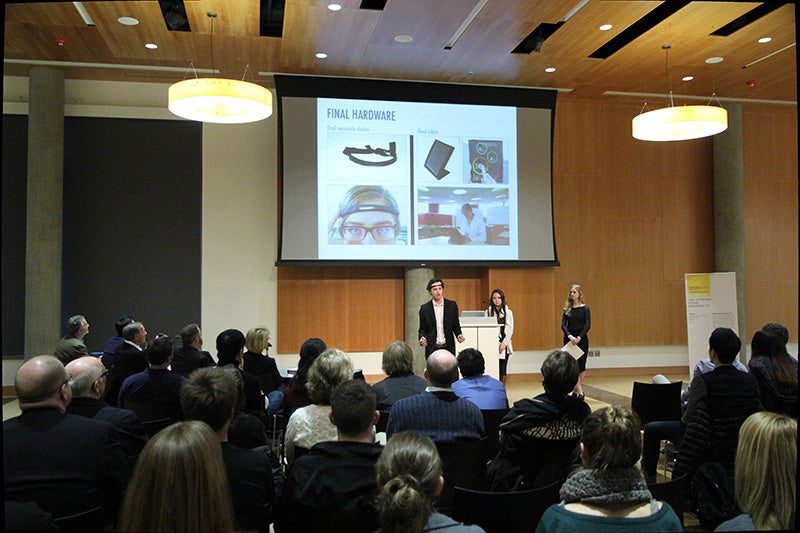
Above: IRIS team members (from left) Logan Olson—wearing the device on his head—Claire Sakaguchi, and Sara Birns make their presentation at the “Duck Tank” Colligan competition. Photograph by Jack Liu.
Germany was pleased by the competition process and outcomes. “I think it’s great if students get engaged in an opportunity like this and realize that they can take the concepts that they develop on campus and advance them. They go through that whole process of working in a group, how you advance those ideas, and do they have value. It encouraged interdisciplinary thinking around technology, and showed them [they can] think beyond coursework, that these ideas have meaning beyond getting a grade or getting a degree.”
Germany said he was “satisfied by the diversity of design concepts the students [conceived]. It’s exciting for the students, too, because some classes are highly constrained—they’re about one thing, and they spend the term developing alternatives to that one problem. For this competition, though, the students did the research and narrowed down their alternatives and refined them. I was pleased with how much they were engaged with the general problem and the potential of opportunities for wearable computers.”
Germany and Ken Kato, associate director of the InfoGraphics lab, were the two faculty coaches invited to oversee the students’ work during the competition. They worked with Colligan and Kimberly Espy, vice president for Research and Innovation, dean of the Graduate School, to plan the interdisciplinary aspects of the competition.
Colligan created the challenge originally as a way to “create more tech businesses in the Eugene area with UO graduates. Then, thinking further about it … I thought, well, here we could take a real strength of the university, which is arts, architecture, graphic design, and bring some of those capabilities to bear in the tech business by creating a graphical user interface design challenge. Hopefully the end result of this challenge will be to create a new area of expertise at the UO.”
He wanted to open the competition to all disciplines because, he said, “No one group has a monopoly on good ideas or design—they can be computer scientists, they can be business people, or they can be designers. I’m hopeful we can leverage the broad base of talent at the university and bring a technology focus to the curriculum. …What I’d like to see is for this to snowball into an area of expertise for the university. At some point it could even be a degree area of study and it starts being recognized as an area of excellence for the school. “
Colligan, who enjoyed sixteen successful years as a leader at both Handspring and Palm, continues to be actively involved in technology as an investor at his venture capital and private equity firm Edventures.
KEZI-TV and KLCC-FM each aired a story about the challenge.
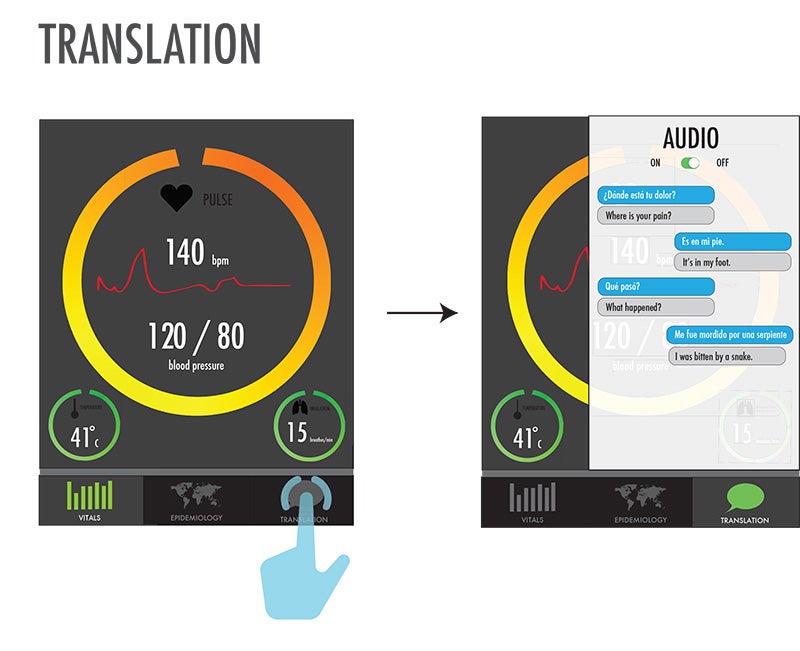
Above: IRIS collects vitals simultaneously when approaching a crisis patient. Typically it would take three or four devices to collect this information but IRIS, developed by Product Design Program undergraduate students, uses only one. Vitals that are critical will be large and called out in a warning color. The physician can click into a vital to see an enlarged version, but all the other vitals are still referenced.
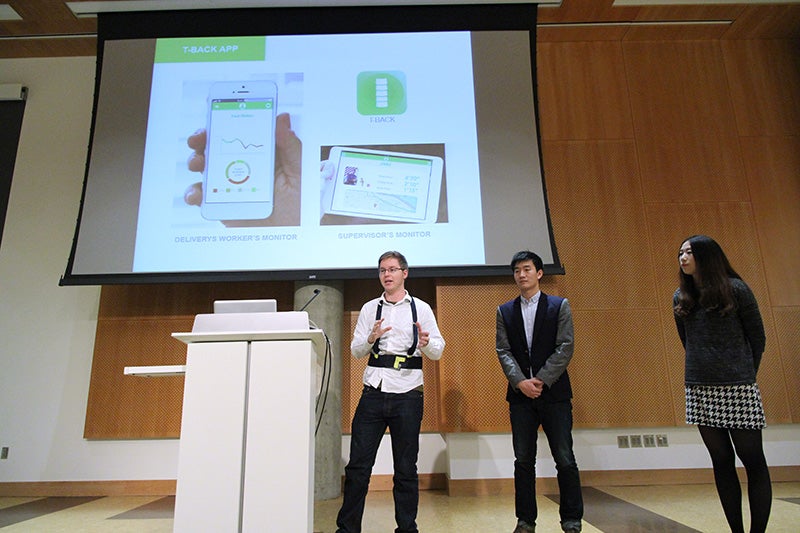
Above: (from left) Cole Harder, Yu Zhang, and Yawei Zhang—developed a wearable computing system to monitor and track delivery workers’ physical status to prevent injuries by giving suggestions based on data collected during the workday. Photograph by Jack Liu.

Above: A page from Team T-Back’s presentation shows initial drawings and research aspects of their concept.
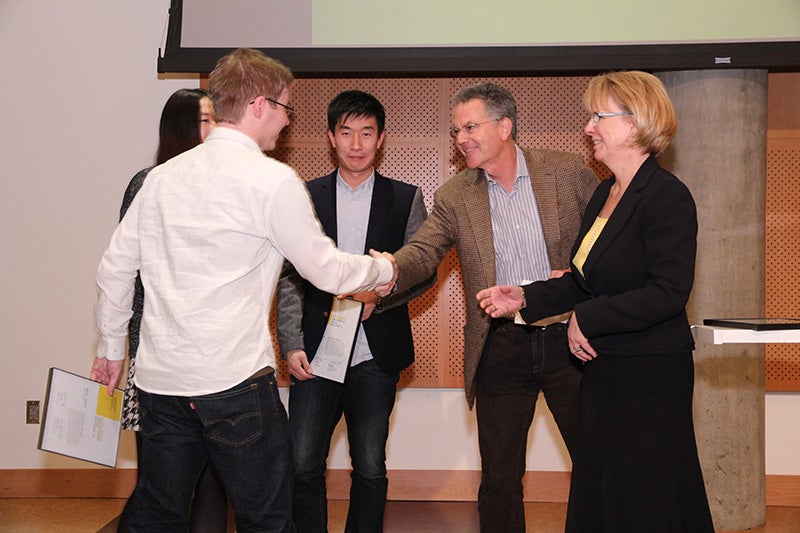
Above: Ed Colligan extends a hand to congratulate Team T-Back member Cole Harder while his teammates Yawei Zhang and Yu Zhang, and Kimberly Espy, vice president for Research and Innovation, dean of the Graduate School, look on. Photograph by Jack Liu.
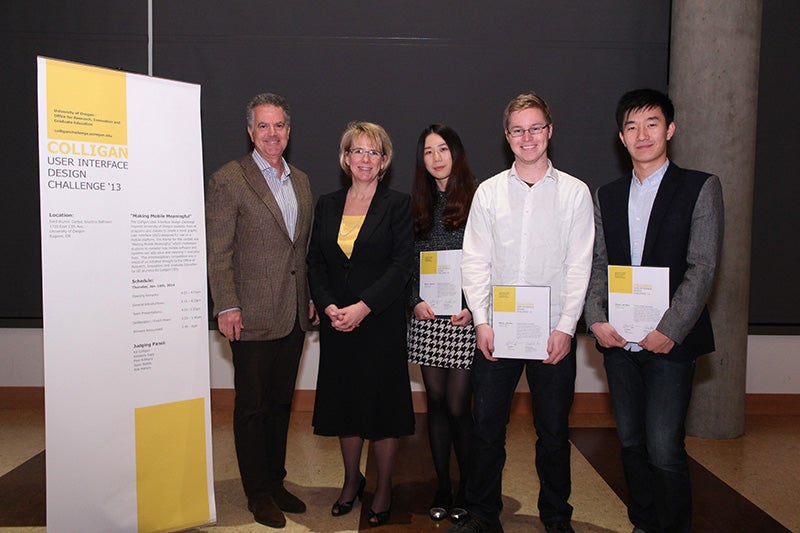
Above: Ed ColliganEd Colligan and and Kimberly Espy, vice president for Research, dean of the Graduate School, congratulate Team T-Back members (from left) Yawei Zhang, Cole Harder, and Yu Zhang on their fourth-place finish. Photograph by Jack Liu.
